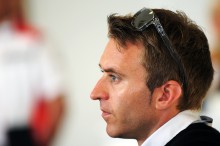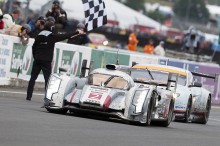INGOLSTADT, Germany — You might say that Chris Reinke is “Living the dream” — his dream. Ever since he was six years old he has dreamed of building world’s best cars. Today he is the head of the LMP program for Audi and on Saturday the 2014 version of the Audi R18 e-tron quattro, a car that Reinke has had responsbility for developing, will defend the Le Mans and WEC championship that it won in 2013.
In the ultimate test of endurance and speed, the R18 will do battle on the Circuit de la Sarthe beginning on Saturday for the 2014 version of the 24 hours of Le Mans, along with WEC series leader Toyota, and Porsche, that returns to Le Mans in the LMP category after a 16 year hiatus.
With his focus on building race cars Reinke’s education has been a mix of formal learning punctuated by a series of real world opportunities in racing. He earned a degree in automotive engineering from university in Germany, but the route to graduation was not a straight line.
In 1995 he had the opportunity to assist mechanics and work with Reeves Callaway on a Corvette that was being prepared for Le Mans.
It was a six month sojourn from academia that was Reinke’s first foray into racing as an engineer and as a part of the team got him to Le Mans for the first time as a crew memeber. The car, a Corvette that was entered in the GT2 class, qualified first in its class and finished third in the class and 11th overall.
Today, Reinke lists Callaway Competition as providing inspiration and along the way mentorship for him to reach his goal. “They gave me the possibility and that’s where it all started — it was the first step into the motorsport world.
“I only did a summer job with Reeve in Old Lyme, Connecticut. He said ‘ We are about to build a Le Mans car at Callaway Competition in Leingarten (Germany), can you come and give us a hand’.
“I said ok. If I get asked for that I might as well stop my studies for half a year. That was my first time to work on a race car and I had the probability to be in Le Mans, to be on the pit lane, to smell the gasoline. I guess that had a lot to do with my affection, with my dedication to Audi,” he said.
After earning his degree in automotive engineering, Reinke realized that he was not enough of a specialist to make it big in the racing industry and took another degree from Plymouth University in the United Kingdom in composite engineering.
Reinke then had the opportunity to work with the Toyota Formula One project where he eventually was eventually in charge of the monocoque. Reinke wanted to be more involved in the total preparation of the car and so, in his own words, he took a step back to re-stage himself.
That led to a number of freelance jobs, one working on an Indy Car project for Dallara where he was also to find the Audi TT DTM car in the wind tunnel. One thing led to another and soon Reinke was working with Audi. Since 2007 he has been involved with the Audi Diesel project, starting with the R10. Last year he was put in overall charge of the LMP project.
In this role Reinke has realized his dream of building a total car. The responsibilities are immense as he has charge for defining the specifications for the race car both in terms of building a winning racer and integrating the branding and marketing requirements from Audi. In this role he also has budget responsibilities (and keep in mind that the budget for this kind of an endeavor we are talking about “cubic dollars”). Additionally, in this role, Reinke is the team liaison with the sanctioning bodies of the series, the FIA and the ACO.
The last two years have been exactly what Reinke has prepared his whole life for as the Audi team have had to take their successful R18 e-tron quattro and re-engineer it to meet the new rules that are in place for the FIA World Endurance Series which will see competitors using up to 30 percent less fuel but going just as fast.
On Monday afternoon (June 9) the Audi team will go through scrutineering before the week at the Circuit de la Sarthe begins in earnest.
We were able to catch up Reinke prior the start of the Le Mans speed week and here is his view on the new Audi racer.
Chris, can you tell us a little about your pathway to becoming the head of the LMP program at Audi. Specifically, where did you go to school and what did you study. How did you wind up in racing?
To wind up in racing was an earlier dream of my childhood where I was kind of infected following an annual vintage race in my hometown. Following my studies of Automotive Engineering at the University of Applied Science in Ulm, GER I took a second degree in Composite Material Engineering at the University of Plymouth, GB. During this period I actually “served” my first Le Mans race in 1995 as a mechanic within Callaway Competition’s GT program. Starting my professional career in the Formula 1 project of Toyota in 1999, I joined Audi’s DTM program in 2002 to transfer to the LMP squad from 2005 onwards, taking the position of the Technical Project Manager in 2008. 2013 eventually I was appointed the Head of LMP.
I am sure that you have been thinking about the development of the new car for some time. Can you give us an idea of how the development cycle with the car works. And specifically what is your part in the process.
In general, we have an established process for developing new cars at Audi Sport. Our work with the 2014 Audi R18 e-tron quattro did start in 2012 already. First, you begin with a concept before you actually start designing the car. Each part of the latest car is an all-new design due to the new set of regulations. Literally nothing has been carried over from the previous car. As Head of the LMP project, my part is to oversee the procedures in place, to co-ordinate between all departments and to make sure we develop a competitive racer within our budgeted boundaries before it hits the track in anger in April 2014 at Silverstone for the first WEC race.
This year your “friends” at Porsche come back to the LMP fight. How difficult is it to be competitive with a team this is actually a part of your global company, for which it appears some of the technology has been used in the development of R18 e-tron quattro?
For Audi, Porsche is a competitor like all the other opponents as well. The reason is very simple: At the end of the day, you need to beat the opposition on the track. The timing sheets at the end of the race are the only things that count if you want to become a World Champion. As for the technology: We have developed a completely new race car, and Porsche had to start from scratch anyway, so there’s certainly no transfer. The only technology transfer is within Audi: between the our race cars and our road cars. That’s what we have been doing for more than 30 years now, beginning with the legendary Audi quattro in the 1980s.
The new rules that the ACO / FIA will indoctrinate for the series in 2014 will pay dividends to those who can go fast, and be fuel efficient. For the 24 hours of Le Mans and for the WEC series there is also an element of endurance that must be accounted for. What other areas will there be changes or improvements in the new car, given that the design of any vehicle is a series of trade-offs.
The idea behind efficiency is that energy is limited to a certain amount per lap. So if you are efficient, you use the same amount of energy like the others, but you are faster than they are. Speed and durability are the prerequisites to be competitive, but in addition, you need to be even more efficient than last year. All areas of the car are affected by changes. The new rules have so many implications regarding efficiency and safety that it’s an all-new car.
The decision making for the new car design is driven we assume by a number of factors. Certainly that is collected during testing and races for the last decade or so is important. What other areas of “knowledge” that help in the design decision making. Is there a balance between explicit data and implicit intuition in the decision-making process
?
Explicit data are one aspect, tools of analysis and simulation play another important part. Intuition is extremely important as the LMP rules allow for greater freedom in many areas when compared to other vehicle categories in motorsport. Don’t forget: we are allowed to build two or four-wheel drive cars, petrol or diesel engines, one or two hybrid systems etc.
How data driven is the development process. By that we mean: Audi obviously has collected a great deal of data over the last 15 years from the various races. Is this data used to develop the basic “model” for the new car or is there also input into the design based on the “human intuition” of engineers and drivers?
We have collected many data, but with every new generation of car, the data change as well. Of course this helps to define a basic concept, but simulation is very important as well. Every engineer brings his education, his ideas and his experience with him, so their ideas are crucial for progress as well.
From the latest release about the car, it sounds as if the new design is significantly more complex, particularly with respect to the drive system. It is our experience that as complexity of a system is increased, it puts a greater cognitive load on the end user. That seems to indicate that the new car will be even more highly computer controlled than ever. Is that correct? And if so, will there be any ability for the driver to be able to override the computer control of the car?
Any complex car needs a form of control systems, and electronics in motorsport are not new. Of course, a driver is always in control of the car. He will certainly not lap the Le Mans circuit radio-controlled by our engineers. In fact, already now, the driver uses software to gain the best support, beginning with different engine or traction control mappings up to a lap and split timer that helps him adjusting his speed etc. In the future, this will be even more complex. And already now, software supports the drivers in various ways similar to driver-aid applications to be experienced in any Audi road car
The most recent release from Audi indicated that this car would also be designated R18. Is there a specific reason that this car is not getting a new designation?
Already three years ago when the first R18 TDI has been launched, Audi Sport has announced that there is a change in its designation system. Audi Sport now follows the path of the road car designation where the car model names (A3, A4 etc.) are kept through the different vehicle generations since the 1990s. That’s why the LMP sports cars have been called R18 since 2011.




